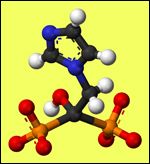MBCC: No Clear Answer for Bisphosphonate Use in Early Breast Cancer
Over the past several months, the results of four randomized bisphosphonate adjuvant trials in a range of different patients have been released, two of these trials showed a survival benefit for the addition of a bisphosphonate to standard systemic therapy. ER-positive patients who are postmenopausal and have had no chemotherapy seemed to benefit the most.
"I know we are all confused about what is going on with the use of bisphosphonates in the adjuvant setting to reduce recurrence," said Julie R. Gralow, MD, speaking at session on bisphosphonates at the 29th Annual Miami Breast Cancer Conference.
Dr. Gralow is the director of breast medical oncology at the Fred Hutchinson Cancer Research Center in Seattle, Washington, and an active researcher and leader of clinical trials, including an adjuvant bisphosphonate trial for prevention of bone metastases in early-stage breast cancer.

3D model of zoledronic acid chemical structure
Breast cancer cells invade the bone, releasing cytokines and growth factors to directly or indirectly stimulate osteoclasts, the cells in the bone that control the amount of bone tissue and function in bone resorption. Bone resorption then results in cancer cell stimulation through a different set of cytokines and growth factors, completing a "vicious cycle," as Dr. Gralow described it. Targeting the osteoclasts to block bone resorption is one method to break this cycle.
What is the Evidence?
The results of 4 randomized bisphosphonate adjuvant trials in a range of different patients were recently presented at the San Antonio Breast Cancer Symposium (SABCS) in December 2011. The duration of the trials was between 2 and 3 years. Two of these trials showed a survival benefit for the addition of a bisphosphonate to standard systemic therapy.
The results, as highlighted by Dr. Gralow, suggest that the role of bisphosphonates in preventing breast cancer is still not clear.
Zoledronic Acid Trials
There have been 3 trials testing zoledronic acid in the early breast cancer setting.
The ABCSG-12 trial "surprised us all," said Dr. Gralow. The trial tested zoledronic acid in premenopausal women with estrogen-receptor (ER)–positive breast cancer who also received ovarian suppression and endocrine therapy. The trial showed a disease-free survival benefit for every 6 months of therapy with the bisphosphonate. The follow-up results, presented at SABCS showed an overall survival benefit as well-for 6 doses spread out over a 3-year period.
In postmenopausal women that were ER-positive, the ZO-FAST trial, also reported at SABCS, showed a 34% improvement in disease-free survival at 5 years for patients receiving therapy every 6 months compared to patients whose zoledronic acid treatment was delayed, only upon an evident fracture or other evidence of bone deterioration.
"The numbers are small numerically at this point, but certainly the trial shows a reduction in recurrences due to therapy," Dr. Gralow said.
In another phase III trial, the UK-based Adjuvant Zoledronic Acid to Reduce Recurrence (AZURE) trial, early-stage breast cancer patients were randomized to a frequent bisphosphonate regimen. The trial showed no benefit of adding zoledronic acid to their systemic regimen.
How Does This Add Up?
Patient subanalysis shows that women who have been postmenopausal for at least 5 years had some benefit in the AZURE trial.
"The original reason for adding zoledronic acid to a systemic regimen in the [ABCSG-12 trial] was to prevent loss of bone mineral density," said Dr. Gralow. However, it was also specified to look at recurrence and death in these women, added Dr. Gralow. The follow-up of the trial showed a 37% reduction in death (P = .048). Dr. Gralow suggested that there might be a direct effect of the bisphosphonate on tumor development based on an observation that there was a difference between local/regional recurrences in those patients who received zoledronic acid therapy compared to those who did not.
The problem with comparing the trials is that there are many differences in the types of patients (stage, postmenopausal, or premenopausal) as well as the drug regimen. One constant among the trials was the accrual of ER-positive patients-100% of the ZO-FAST and ABCSG-12 trial patients were ER-positive and about 78% of the AZURE trial patients were also ER-positive.
What is it that is common among these trials that appear to be positive? asked Dr. Gralow. "All of the women who responded were ER-positive … all patients in the positive trials had spontaneous or induced ovarian suppression."
"When I am asked, ‘Which patients should I think about who would benefit from zoledronic acid in the adjuvant setting, irrespective of the bone density issue?’-it is the people who are ER-positive, are generally postmenopausal, and who have had no chemotherapy," Dr. Gralow clarified.
Dr. Gralow added that she does not know for sure that this is correct and is not sure that zoledronic acid should be approved specifically for these patients, but that "we have to treat the patients who are in front of us, and this is the best evidence we have so far," providing an insight for the clinicians to go back to their practice and apply what they learned in Miami.